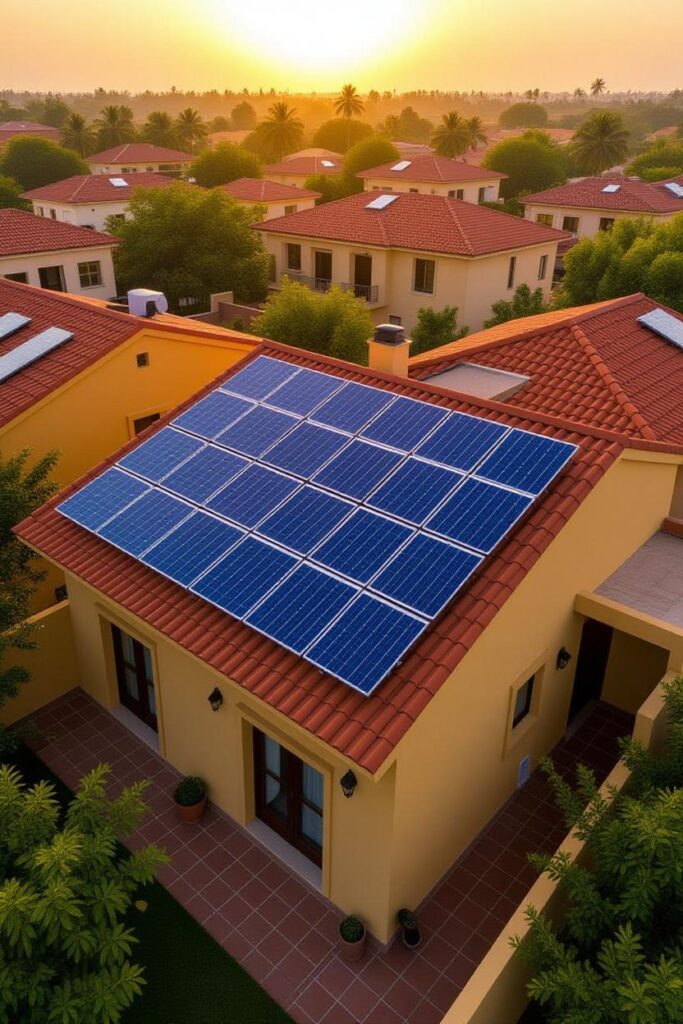Detailed Guide with Examples

When you decide to install a solar rooftop system for your home or business, one of the first questions you’ll face is:
“Should I go for on-grid, off-grid, or hybrid?”
Each type of solar setup works differently — in how it connects to the grid, manages energy, and powers your home. Choosing the right one can affect your savings, reliability, and long-term return on investment.
In this guide, we’ll explain all three types of solar systems in depth, with practical examples and real-life use cases.
☀️ 1. On-Grid Solar Rooftop System (Grid-Tied System)
🔹 What It Is
An on-grid solar system is directly connected to the state electricity grid (DISCOM). The power generated by your solar panels is first used to run your home’s electrical appliances. Any surplus electricity is exported to the grid, and any shortfall is automatically imported from it.
This system works on the net-metering mechanism, where you’re billed only for the net energy consumed (energy imported – energy exported).
⚙️ How It Works
- Solar panels generate DC electricity from sunlight.
- Grid-tied inverter converts DC into AC, synchronizing it with the grid.
- Energy is first consumed in your house; any extra energy goes to the grid.
- At the end of the billing cycle, your DISCOM calculates your net units (import vs export).
💡 Example
Let’s say your home produces 500 units (kWh) through solar in a month.
You consume 550 units in total.
- You export 500 units and import 550 units from the grid.
- So, your net consumption = 550 – 500 = 50 units.
You’ll only pay for 50 units!
If you export more than you consume, the excess will carry forward as credit (depending on your DISCOM policy).
✅ Advantages
- Lower upfront cost (no batteries).
- Eligible for MNRE rooftop subsidy.
- Simple, reliable, and easy to maintain.
- Best suited for locations with stable grid power.
⚠️ Limitations
- Does not work during power cuts, since grid-tied inverters automatically shut down (anti-islanding safety feature).
- Requires a net-metering approval from your DISCOM.
🏠 Ideal For
Homes and businesses in urban or semi-urban areas with good grid connectivity and minimal power outages.
🔋 2. Off-Grid Solar Rooftop System (Standalone System)
🔹 What It Is
An off-grid system operates independently of the grid. It uses batteries to store energy generated by solar panels, allowing you to power your home even when the sun isn’t shining — or when there’s a power cut.
These systems are common in remote villages or rural areas where grid power is unreliable or unavailable.
⚙️ How It Works
- Solar panels generate DC power from sunlight.
- A charge controller regulates charging and discharging of the batteries.
- The battery bank stores energy for night or backup use.
- The off-grid inverter converts DC to AC and powers your appliances.
💡 Example
Imagine a farmhouse that consumes 8–10 units/day and faces long power cuts.
A 5 kW off-grid system with a battery bank can store around 10–12 kWh/day, enough to run lights, fans, a refrigerator, and a water pump for several hours even at night.
✅ Advantages
- Works independently of the grid — perfect for remote areas.
- Provides 24×7 backup power.
- You don’t depend on DISCOM or net-metering policies.
⚠️ Limitations
- Higher cost due to batteries (which need replacement every 5–7 years).
- Maintenance-heavy (battery care, water topping for lead-acid).
- Not eligible for central government rooftop subsidy under MNRE.
🏠 Ideal For
Farmhouses, rural homes, schools, or institutions in areas with frequent power cuts or no grid access.
⚡ 3. Hybrid Solar Rooftop System (Smart Combination)
🔹 What It Is
A hybrid system combines the best of both worlds — it is connected to the grid and also uses a battery bank for energy storage.
It can supply power to your home, export excess to the grid, and provide backup power during outages. This makes it the most flexible and advanced option among the three.
⚙️ How It Works
- Solar panels generate DC power.
- The hybrid inverter intelligently decides:
- First, supply power to home loads.
- Second, charge the battery bank.
- Third, export surplus power to the grid.
- During power cuts, the inverter automatically switches to battery backup, ensuring uninterrupted supply.
💡 Example
Let’s say your system produces 15 kWh/day and your home uses 12 kWh/day.
- Daytime: 8 kWh goes directly to home loads, 4 kWh charges batteries, and 3 kWh is exported to the grid.
- Night: Your home uses stored battery energy instead of drawing from the grid.
If a power cut happens, the hybrid inverter ensures your essential loads (lights, fans, fridge, Wi-Fi) stay on seamlessly.
✅ Advantages
- Works even during power cuts.
- Provides energy independence and stability.
- Smart energy management via hybrid inverters.
- Can participate in net-metering (check DISCOM regulations).
⚠️ Limitations
- Higher initial cost (due to battery + smart inverter).
- Subsidy eligibility varies (check MNRE and DISCOM rules).
- Requires professional installation and configuration.
🏠 Ideal For
Urban or semi-urban homes that face occasional power cuts, and those wanting both savings and backup without running a generator.
⚖️ Comparison Table — On-Grid vs Off-Grid vs Hybrid
| Feature | On-Grid | Off-Grid | Hybrid |
|---|---|---|---|
| Grid Connection | ✅ Yes | ❌ No | ✅ Yes |
| Works During Power Cut | ❌ No | ✅ Yes | ✅ Yes |
| Uses Battery | ❌ No | ✅ Yes | ✅ Yes |
| Initial Cost | 💰 Low | 💰💰 High | 💰💰💰 Higher |
| Maintenance | Low | Medium | Medium |
| Eligible for MNRE Subsidy | ✅ Yes | ❌ No | ⚠️ Depends on state policy |
| Ideal For | Urban homes with reliable grid | Rural areas | Homes needing backup + savings |
⚙️ Real-World Example (Bangalore Scenario)
Let’s say a homeowner in Bangalore consumes around 700 units/month.
- On-grid 5 kW system: Generates ~600–650 units/month → reduces electricity bill to ~₹300–₹400/month.
- Off-grid 5 kW system: Covers full consumption but needs large battery capacity (~₹1 lakh extra).
- Hybrid 5 kW system: Runs essential loads during outages and still participates in net-metering — best of both worlds, but costlier upfront (~₹70,000–₹1 lakh more than on-grid).
🏁 Final Thoughts
Choosing between on-grid, off-grid, and hybrid systems depends on your electricity needs, grid reliability, and budget.
- Go On-Grid if you want the highest ROI and have reliable grid supply.
- Go Off-Grid if you live in remote areas with frequent power cuts.
- Choose Hybrid if you want energy independence with backup + savings.
Before finalizing, always consult a trusted solar professional to evaluate your roof, energy usage, and location-specific factors.
🔆 Let’s Find the Right System for You
Thank you for taking the time to read this article.
If you’re interested in installing a solar rooftop system or unsure which type suits your home, I can personally guide you through every step — from load assessment to proposal and installation.
📞 Contact: +91 86608 21746
📧 Email: brindavansolutions@gmail.com
🏢 Company: Brindavan Solutions, Bangalore
👉 Interested in solar? Get your free proposal and site survey with just one click!
Chat with us on WhatsApp
